
Active shooter incidents escalate quickly and evolve rapidly. While many conclude after a few short minutes, others stretch on for hours.
To address these incidents, the Department of Homeland Security’s (DHS) National Protection and Programs Directorate (NPPD) has released a new edition of “K-12 School Security: A Guide for Preventing and Protecting against Gun Violence” (2nd ed., 2018) which provides preventive and protective measures to address the threat of gun violence in schools.
Professionals should use these resources to protect their schools, safeguard the lives of their students, faculty, and staff, and facilitate the recovery process following this type of incident.
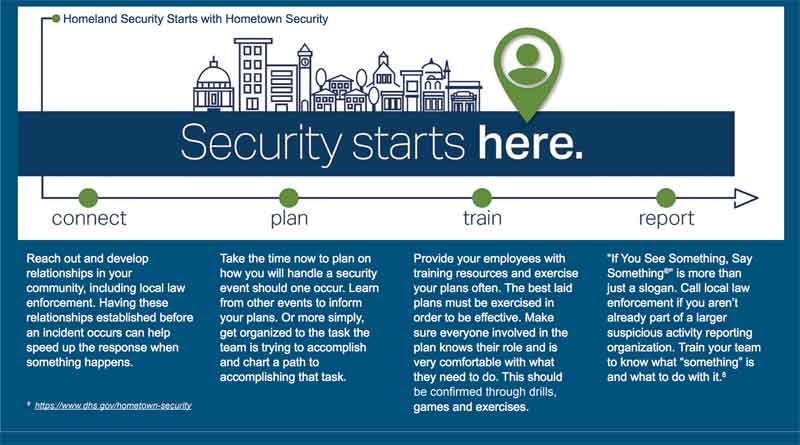
Preparedness (Prevention, Protection, Mitigation)
- Prevention: This mission area focuses on the ability to avoid, prevent, or stop an imminent threat.
- Protection: This mission area focuses on the ability to secure and protect a community against a variety of threats and hazards.
- Mitigation: This mission area focuses on the ability to reduce the loss of life and property by lessening the impact of a disaster.
These resources are provided to assist in building campus resilience by adequately preparing for and responding to violent incidents.
The Guide is delivered in two parts:
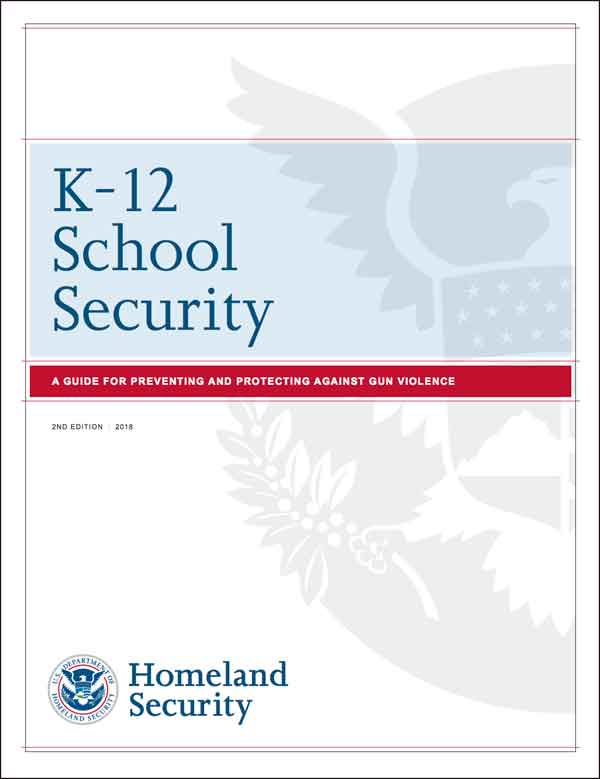
The first portion is a PDF with general security best practices and considerations in narrative format, while the second portion is a Microsoft Excel-based security survey.
Together, these documents outline action-oriented security practices and options for consideration based on the results of the individual school’s responses to the survey.
While the primary audience for the Guide is the K-12 community, institutions of higher education or pre-K schools may also benefit from the information presented.
The guide and survey is available on the Campus Resilience (CR) Program Resource Library under the School and Workplace Violence active shooter guides and best practices.
For more information, please contact the Office of Academic Engagement at AcademicEngagement@hq.dhs.gov.
Additional Guides, Resources, Best Practices and Training Information Include:
Active Shooter Preparedness: Run. Hide. Fight Program
This Department of Homeland Security website provides information on the Run. Hide. Fight Program, which provides products, tools, and resources to help all audiences prepare for and respond to an active shooter incident.
Higher Education Institutions – Complex & Underprepared for Active Shooter
This article discusses preparedness gaps in Institutions of Higher Education (IHE) emergency plans in the face of active shooter situations.
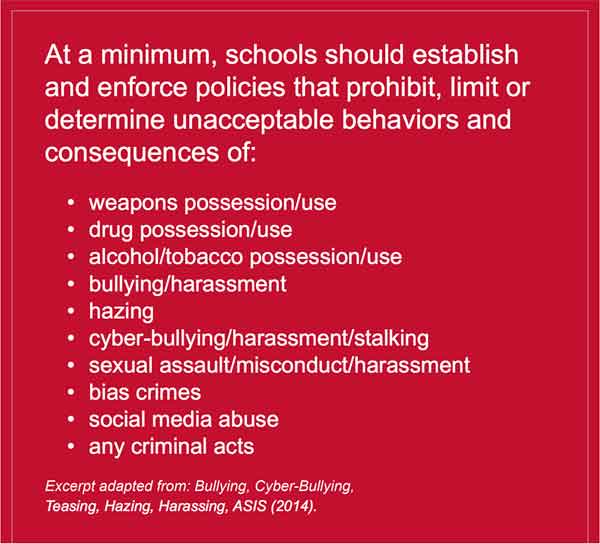
Active Shooter Situations: Preparing for an Active Shooter Situation
This resource offers best practices for preparing for an active shooter situation.
Active Shooter Situations: Preventing and Active Shooter
This resource highlights pre-active shooter attack behaviors displayed by past offenders as means of preventing an active shooter situation.
Active Incident Training: Preparing for the Future Threat
This article asserts that preparation must go beyond incident response, tactics, and the focus on active shooters.
20 Active Shooter and Active Killer Prevention Strategies
This resource provides a myriad of active shooter and active killer prevention strategies.
Research and Reports:
Progress Report on the President’s Executive Action to Reduce Gun Violence
This resource provides a progress report on Presidential efforts to reduce gun violence.
One Voice on Disaster Preparedness
This article discusses how Run. Hide. Fight. changed the national dialogue on civilian safety.
Trainings:

Active Shooter: What You Can Do Training Course
This course provides guidance to individuals, including managers and employees, so that they can prepare to respond to an active shooter situation.
Options for Consideration Active Shooter Preparedness Video
The Options for Consideration video demonstrates possible actions that individuals can take if confronted with an active shooter scenario.
This instructive video reviews the choices of running, hiding, or as an option of last resort, fighting the shooter.
The video also shows how to assist authorities once law enforcement arrives.
Active Shooter Emergency Action Plan Video
This video describes the fundamental concepts of developing an Emergency Action Plan (EAP) for an active shooter scenario.
This instructive video guides viewers through important considerations of EAP development utilizing the first-hand perspectives of active shooter survivors, first responder personnel, and other subject matter experts who share their unique insight.
Active Shooter Awareness Virtual RoundTable (Webinar)
This online webinar helps critical infrastructure owners and operators to understand the importance of creating an emergency response plan and exercising that plan and training hourly employees on how to respond should they find themselves confronted with the danger of an active shooter incident.
Nationwide Suspicious Activity Reporting (SAR) Initiative
This website provides information on the Nationwide SAR initiative, which aims to facilitate the gathering, documenting, processing, analysis, and sharing of suspicious activities.
Response

This mission area focuses on the ability to save lives, protect property and the environment, as well as meet the basic needs of a community during a disaster.
Guides and Best Practices:
Active Shooter How to Respond
This resource helps IHEs prepare for and manage an active shooter incident.
Active Shooter Event Quick Reference Guide
This pamphlet prepares bystanders to run, hide, or fight an active shooter before law enforcement arrives.
Active Shooter Poster – How to Respond When an Active Shooter is in Your Vicinity
This resource helps businesses prepare to respond and manage an active shooter situation.
Active Shooter Pocket Card
This resource helps individuals prepare for and respond to an active shooter incident.
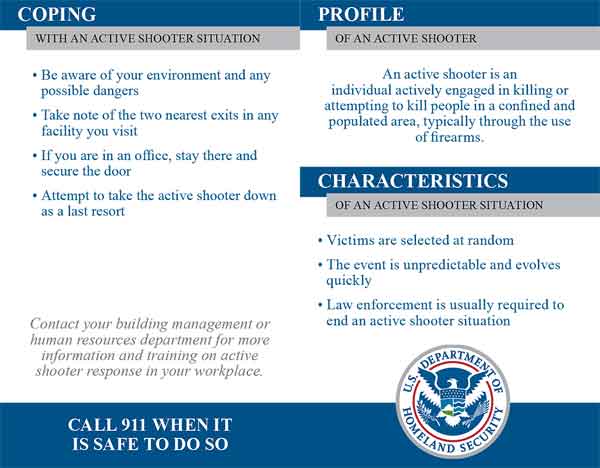
FBI’s Active Shooter Resources Webpage
This FBI resource provides operational, behaviorally-based threat assessment and threat management services to help detect and prevent acts of targeted violence, helping academic, mental health, business, community, law enforcement, and government entities recognize and disrupt potential active shooters who may be on a trajectory toward violence.
Fight, Flight, or Lockdown – Teaching Student and Staff to Attack Active Shooters Could Result in Decreased Casualties or Needless Deaths
This article discusses developing trends in active shooter response training.
Active Shooter Situations: Interacting with First Responders
This resource discusses the need to train students and staff how to interact with first responders in the wake of an active shooter attack.
Effective Active Shooter Response Starts with Integrated Campus Solutions
This article discusses best practices to maximize the efficiency and emergency preparedness of campuses with an all-in-one platform.
First Responder Guide for Improving Survivability in Improvised Explosive Device and/or Active Shooter Incidents
This document incorporates military response strategies and civilian best practices into a first responder guide for explosives attacks and active shooter incidents.
Research and Reports:
Order in the Emergency – The Importance Staging Area to Manage Crisis
This article discusses the importance of staging areas throughout the entirety of the crisis-response process.
Trainings:
Enhanced Dynamic Geo-Social Environment (EDGE) Virtual Active Shooter Training
Provided by the Department of Homeland Security, Science and Technology Directorate, EDGE is a multiplayer, scalable, online training environment for first responders to train a coordinated response to critical incidents. The first scenario includes an active shooter incident.
DHS New EDGE School Active Shooter Responder & Staff Training (Video)
Active Shooter Training for Law Enforcement Officers
This website provides information on four training programs offered through the Federal Law Enforcement Training Centers.
These programs are designed to provide law enforcement officers with threat awareness, analytical knowledge, tactical skills, and emergency first aid skills for responding to an active shooter situation.
Introduction to Tactical Emergency Casualty Care (TECC) Training Course
Sponsored by George Washington University, this course provides members of the general public (whole community) including school personnel, public works officials, and first responders the information and skills they need to help themselves and others survive an active shooting/active killing incident.
Introduction to Tactical Emergency Casualty Care for First Care Providers Training Course
Sponsored by George Washington University, this course provides the general public, as well as school personnel, the information and skills they need to help themselves and others survive an active shooting/active killing incident with a focus on first care providers.
Tactical Emergency Casualty Care for Law Enforcement Personnel Training Course
Sponsored by George Washington University, this course trains law enforcement personnel about the TECC phases of care, including evacuation techniques.
Law enforcement personnel will learn how to prioritize TECC coordinated actions in a high threat active shooter/active killing situation in order to minimize the number of casualties.
Tactical Emergency Casualty Care for Fire and EMS Personnel Training Course
Sponsored by George Washington University, this course trains fire and EMS personnel about the TECC phases of care, including evacuation techniques.
Fire and EMS personnel will learn how to prioritize TECC coordinated actions in a high threat active shooter/active killing situation in order to minimize the number of casualties.
Tactical Emergency Casualty Care for First Receivers Training Course
Sponsored by George Washington University, this course teaches medical First Receivers how to care for victims of a high-threat mass casualty shooting/explosion.
First Receivers will know the types of injuries that are common in these mass casualty situations and how to prioritize treatment based on TECC guidelines.
Tactical Emergency Casualty Care First Responder Integration Active Shooter/Killing Incidents Rescue Task Force Training Course
Sponsored by George Washington University, this course provides Law Enforcement, Fire and EMS commanders with the training to meet communication needs and challenges associated with an active shooter/active killing incident.
Recovery
This mission area focuses on the ability to assist communities in recovering effectively following a disaster.
Guides and Best Practices:
Active Shooter Situations: After an Active Shooter Incident
This resource offers essential EOP steps to implement after an active shooter incident occurs.
All
Resources that fall into the “All” category contain useful information and guidance that is relevant to all FEMA Mission Areas.
Guides and Best Practices:
Planning and Response to an Active Shooter: An Interagency Security Committee Policy and Best Practices Guide
This resource is designed to be applicable to all buildings and facilities in the United States occupied by Federal employees.
Active Shooter Situations: Exercise
This resource offers best practices for conducting active shooter exercises.
Active Shooter – CHECK THIS
This webpage describes what actions to take before, during, and after an active shooting event and explains the signs of potential violence.
How to Prepare For and Respond During and After an Active Shooter Incident
This document explains what actions to take in preparation for, response to, and recovery from an active shooter incident.
DHS Active Shooter Preparedness
This website provides useful links to products, tools, and resources to help first responders and law enforcement prepare for and respond to an active shooter incident.
The Immigration Debates: Considerations for Campus Police and Security
This resource discusses the issue of on-campus demonstrations and offers considerations for campus police and security.
Youth Preparedness Council
This website includes information on the Youth Preparedness Council, which conducts ongoing disaster preparedness-based engagement with K-12 representatives and campus leaders.
Research and Reports:
Research Shows Mass Shootings Can be ‘Contagious’
This resource discusses a new study regarding the contagious nature of mass shootings.
Aiming at Students: The College Gun Violence Epidemic
This resource analyzes shooting trends at U.S. colleges and reviewed 190 incidents at 142 colleges from 2001 to 2016.
A Study of Active Shooter Incidents in the United States Between 2000 and 2013
This report provides federal, state, and local law enforcement with data and best practices for how to prevent, prepare for, respond to, and recovery from active shooter incidents.
FBI Study of Pre-Attack Behaviors of Active Shooters (Learn More, Videos)
2000 to 2016 Active Shooter Incidents
This document contains a list of active shooter incidents in the United States that have been identified by the FBI from 2000 through the end of 2016.
Trainings:
Emergency Action Planning Trailer
The Active Shooter Emergency Action Planning (EAP) video is a comprehensive active shooter preparedness, response, and recovery resource that utilizes interviews with first responders, survivors of active shooter events, and other subject matter experts to capture best practices and lessons learned.
This video combines state-of-threat awareness with state-of-practice solutions that will empower you to build resilience for your community, organization, family, and home.
Advanced Law Enforcement Rapid Response Training (ALERTT)
This website details training programs provided through the ALERTT Center at Texas State University for active shooter incidents.
Advanced Law Enforcement Rapid Response Training (ALERTT) Video
This video provides an overview of the ALERTT Training program.
(The Advanced Law Enforcement Rapid Response Training (ALERRT) Center’s active shooter program trains state and local law enforcement on how to effectively and safely respond to active shooter events. Courtesy of the Office of Justice Programs and YouTube.)
Critical Infrastructure Training
This webpage provides links to various training programs for government and private sector partners offered by the DHS/Office of Infrastructure Protection. These trainings provide the knowledge and skills to implement critical infrastructure security and resilience activities.
Learn More…
DHS in the 2017 ‘ASTORS’ Homeland Security Awards Program

The U.S. Department of Homeland Security Science (DHS) and Technology Directorate (S&T) was recognized with Four 2017 ‘ASTORS’ ‘Excellence in Homeland Security’ Platinum Awards by American Security Today (AST), at ISC East in New York City.
This awards program was organized by AST to recognize the most distinguished security vendors, as the nation continues to respond to escalating threats from home and abroad.
The innovative solutions being implemented to meet those threats has led to tremendous growth in the field of Homeland Security, and to this awards program for recognition of the key contributors to our nation’s security.
-
Department of Homeland Security (DHS) Science and Technology Directorate (S&T)
- Enhanced Dynamic Geo-Social Environ (EDGE) Virtual Online Training for First Responders Open at No Cost to All U.S. First Responders Agencies, Across Disciplines for Coordinated Response to Critical Incidents
- Excellence in Homeland Security
-
Department of Homeland Security (DHS) Science and Technology Directorate (S&T)
- Resilient Tunnel Plug (RTP) to Strengthen Mass Transportation Critical Infrastructure from Disruptive Flood Events
- Excellence in Homeland Security
-
Department of Homeland Security (DHS) Science and Technology Directorate (S&T) First Responders Group (FRG)
- Flood Apex Program, Applying New & Emerging Technologies to Improve Community Resilience from Flood Disasters, Reduce Fatalities and Property Loss
- Excellence in Homeland Security
-
Department of Homeland Security (DHS) Science and Technology Directorate (S&T) Homeland Security Advanced Research Projects (HSARPA)
- Surface Transportation Explosives Threat Detection (STETD) on Developing the Capacity to Detect Potential Threat Items Throughout Rail and Subway Systems Without Alerting the Subject or Negatively Impacting the Speed of Travel
- Excellence in Homeland Security

Over 100 distinguished guests from National, State and Local Governments, and Industry Leading Corporate Executives from companies allied to Government, gathered from across North America and the Middle East to be honored from disciplines across the Security Industry in their respective fields which included representatives from:
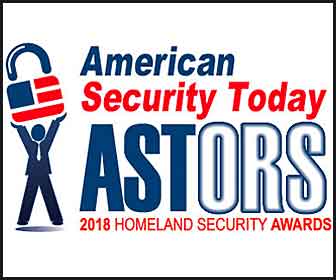 The Department of Homeland Security
The Department of Homeland Security- U.S. Customs and Border Protection
- The Department of Justice
- The Security Exchange Commission
- State and Municipal Law Enforcement Agencies
- The Royal Canadian Mounted Police
- Leaders in Private Security
















